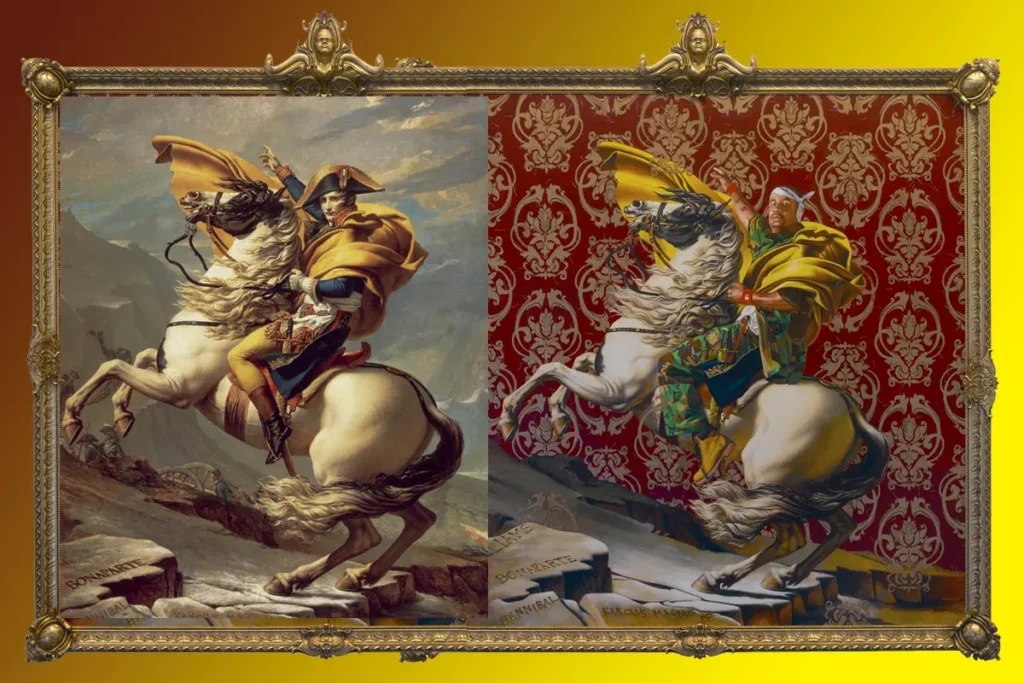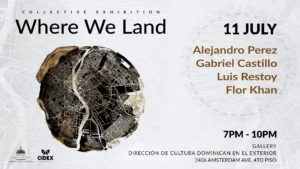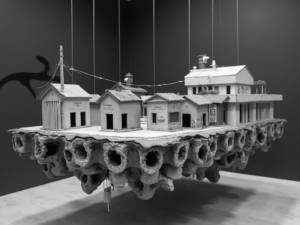By Juan Butten
For me, one of the advantages of living in New York has always been access to so much art. Today, I cross the doors of the Brooklyn Museum with the purpose of seeing “Napoleon Leading the Army over the Alps” (2005) by Kehinde Wiley. I knew that this acclaimed work, praised for its contemporary reinterpretation, would lead me to reflect on its original by Jacques-Louis David, an icon of neoclassical art that has endured through time. However, as I approach, the immensity of the piece impacts me.
Wiley, with his vibrant style, has taken the emblematic image of Napoleon, and I instantly understand that, although both works revolve around the figure of the emperor, their approaches and messages are radically different. David’s painting, created in 1801, depicts Napoleon as an almost divine leader, proudly mounted on his horse and surrounded by an alpine landscape that highlights his greatness. Here, the classical hero is presented as a symbol of power, encapsulating the heroic narrative of European history.
In contrast, Wiley reimagines this figure. His model, a man of African descent, wears an outfit that combines military grandeur with touches of contemporary urban culture. Seeing him, I realize that this choice not only diversifies the representation of the hero but also challenges the monopolization of historical narratives by white figures. Wiley offers us a vision of a leader whose strength and determination invite us to rethink what it means to be a hero today.
I search for David’s work on Google on my phone to compare, and the sober color palette along with the light that models Napoleon’s figure makes me feel the solemnity of his power. The landscape is impressive, but it mainly serves as a backdrop to highlight the protagonist’s greatness.
Shifting my gaze to Wiley’s work, I am enveloped by an almost dreamlike atmosphere. The vibrant colors and dynamic composition create a unique visual experience. Although the alpine landscape remains majestic, here the focus is on the central figure, whose determined gaze challenges traditional notions of heroism. It serves as a reminder that the environment is not just a background; it reflects the diversity and complexity of contemporary identity.
While David focuses on the figure of Napoleon, he perpetuates a vision of history that often excludes diverse voices. His work embodies an artistic canon criticized for its lack of inclusion. Wiley, on the other hand, boldly challenges this tradition. By presenting an Afro-descendant leader, he not only reinterprets the figure of Napoleon but also highlights the absence of representation of people of color in the history of art.
As I observe Wiley’s work, I find myself questioning profound issues: who deserves to be considered a hero? What narratives have been lost? His work invites a necessary conversation about identity and power, raising a dialogue about the multiple realities that coexist in our world.
As I leave the museum, I realize that “Napoleon Leading the Army over the Alps” by Wiley is not just a reinterpretation of a historical image; it is a powerful statement about representation and identity in contemporary art. The way Wiley intertwines the classical with the modern leaves me reflecting on the importance of these discussions. This encounter at the Brooklyn Museum has been a journey through time and meaning, a reminder of how art can transform our perceptions and open spaces for voices that have been silenced.
I leave with a renewed sense of admiration for the diverse narratives that are part of our collective history, and with the hope that, through art, we continue to celebrate the richness of our identities, especially as part of the Afro-descendant diaspora from an island called Hispaniola.









